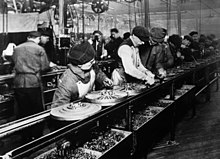
While the mechanization of labor was placed in the field, the cyborgs, half human and half robot were introduced. They were easy to be found in movies where people can express their imagination without the limit to the point where the robots and humans are existed together. Karl Capek disagree with this idea of robots replacing humans responsibilities by stating how it will be horrified that humans are overestimating robots. Japanese invention of robots is highly known among robotic field. The professor Machiko Kusahara mentioned that the robots are made to have friendly manner and appearance instead of brutal or powerful models.The robots they talk about are made of purposes that they are looking for helping and kind figures to humans. The video of "homeless robot" was really interesting that the homeless seem really like a person. We can see how robot system is unconsciously embedded in our reality. It was amazing to see how humans invented robots that resemble to the human themselves.
Dirt: The Homeless Robot
<http://www.youtube.com/watch?feature=player_embedded&v=5HfmKXfp394>
It is easy to find from the movies. Let's compare the two movies that have robots for their main characters. First, the terminator is a famous movie with the man who is not hundred percent human but is powerful with his non-human power that scares the real human. Second of all, there is "Wall-E" shows how robots have emotions like humans do. Humans are abandoned in this movie and this movie depicts how robots fall in love showing emotions and thoughts by robots.
Robots are both biological and artificial and are the result of collaboration of artists, engineers, and scientists. Therefore, the new era of robots are slowly binding into the industry coping with the human culture.
Sources
Vensa, Victoria. Robotics Part 1 Lecture. Cole UC online. Youtube, Apr 15 2012. Web.
<https://www.youtube.com/watch?v=cRw9_v6w0ew#t=719>
Vensa, Victoria. Robotics Part 2 Lecture. Cole UC online. Youtube, Apr 15 2012. Web.
<https://www.youtube.com/watch?v=oAZ8bo9T_Pk>
“Wall-E: Science, Art and the Meaning of Life.” Web log post. The Science Bit. WordPress, 1 Jan. 2012. Web. 18 Oct. 2012. <http://nbarrie.wordpress.com/2012/01/01/wall-e-science-art-and-the-meaning-of-life/>
“Traces: Henry Ford.” Traces. N.p.. Web. 18 Oct 2012. <http://www.traces.org/henryford.html>
Benjamin, Walter. “The Work of Art in Age of Mechanical Reproduction.” Marxists. N.p.. Web. 18 Oct 2012. <http://www.marxists.org/reference/subject/philosophy/works/ge/benjamin.htm>.
Robotics MachikoKusahara, Lecture Video, Apr 14 2012. Web. <https://www.youtube.com/watch?v=xQZ_sy-mdEU#t=981>.


I liked this post. I like how you took examples of Wall-E and the Terminator to elaborate on the professors discussion! It was a complete different approach from what I wrote about in my blog--very interesting!
ReplyDelete